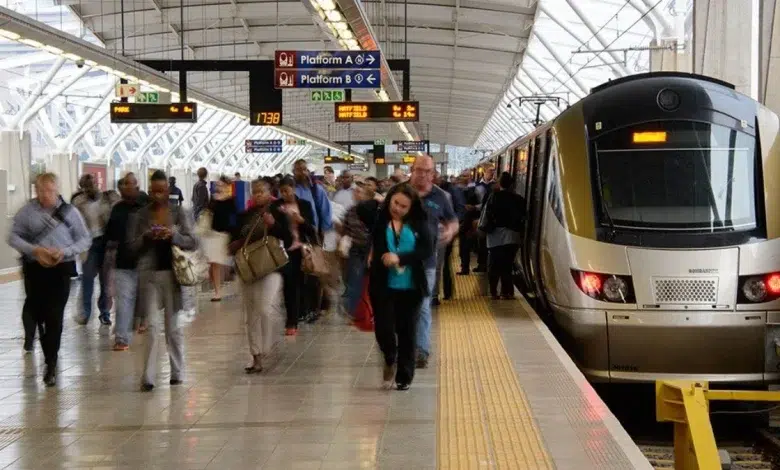From Tracks to Jobs: How Gautrain Boosts Gauteng’s Economy

Since its launch, the Gautrain rapid rail system has been a transformative force in Gauteng, South Africa’s economic powerhouse. Beyond improving public transport, Gautrain has significantly contributed to job creation, urban regeneration, investment attraction, and regional connectivity. This article explores Gautrain’s multifaceted economic impact and its role in shaping Gauteng’s future prosperity.
ALSO READ: More Time, Less Stress: The Lifestyle Perks of Gautrain Commuting
Table of contents
- More Than Just a Transit System
- Job Creation and Sustained Employment
- Stimulating Property Market Growth
- Enhancing Regional Integration and Connectivity
- Attracting Investment
- Supporting Government Social and Economic Priorities
- Innovation and Revenue Diversification
- Expansion and Sustainable Growth
- Economic Growth
More Than Just a Transit System
Designed as a key component of Gauteng’s Integrated Transport Master Plan, Gautrain connects Johannesburg, Pretoria, O.R. Tambo International Airport, and surrounding areas with fast, reliable rail service. But its purpose extends beyond mobility, it acts as a catalyst for economic development, directly influencing property markets, employment, and urban planning.

Job Creation and Sustained Employment
An independent assessment by KPMG demonstrated that Gautrain created approximately 34,800 direct construction jobs and sustains nearly 1,000 permanent positions post-operations. Furthermore, the broader economic ripple supports over 61,000 additional jobs annually across procurement, supply chains, retail, and related sectors.
This employment footprint has importantly included efforts to promote broad-based black economic empowerment, prioritising historically disadvantaged individuals, women, and people with disabilities.
Stimulating Property Market Growth
Studies show that commercial and residential developments around Gautrain stations have accelerated, accounting for almost 60% of metropolitan office space growth in Gauteng’s primary economic nodes. Property values near stations such as Rosebank have appreciated significantly, with some rental rates doubling, reflecting greater demand.
Gautrain has thus played a vital role in urban densification and transit-oriented development, supporting Gauteng’s spatial transformation goals and reducing urban sprawl.
Enhancing Regional Integration and Connectivity
Over 70% of Gautrain trips cross municipal boundaries, connecting the economic hubs in Johannesburg, Tshwane, and Ekurhuleni seamlessly. This integration expands labour markets, enabling Gauteng residents better access to jobs across these major centres.
Improved connectivity fosters economic efficiency and regional competitiveness, essential in supporting Gauteng’s population growth and urbanisation.
Attracting Investment
Since Gautrain’s launch, Gauteng has attracted increased domestic and foreign direct investment. The rapid rail system’s presence enhances investor confidence, showcasing a modern and accessible business environment.
An estimated R46 billion gross domestic product (GDP) contribution is attributed to the Gautrain-induced economic activity, highlighting its importance in Gauteng’s development trajectory.
Supporting Government Social and Economic Priorities
Gautrain extensions planned for Soweto, Fourways, Lanseria, and Mamelodi aim to broaden access to affluent and previously underserved areas alike. These expansions align with government efforts to address apartheid-era spatial inequalities and facilitate inclusive growth.
Further, Gautrain supports Gauteng’s 25-Year Integrated Transport Master Plan, envisaging a comprehensive rail network as the backbone of the province’s sustainable mobility future.
Innovation and Revenue Diversification
Beyond passenger transport, Gautrain stations are evolving into multifunctional hubs incorporating vehicle licensing, retail, business services, and social amenities. This diversification reduces dependency on fare revenues and fosters broader economic activity.
Expansion and Sustainable Growth
Proposed expansions and new stations, like the Lanseria Smart City hub, will further enhance Gauteng’s economic footprint and regional integration. By future-proofing infrastructure, Gautrain prepares to meet increasing demand and support South Africa’s broader economic development goals.
Economic Growth
Gautrain exemplifies how well-planned transport infrastructure can drive economic growth, job creation, and urban renewal. Its role extends from providing efficient mobility to reshaping Gauteng’s economic landscape, promoting investment, and fostering inclusive development. As Gauteng continues to grow, Gautrain remains central to ensuring sustainable prosperity for its residents and businesses.




